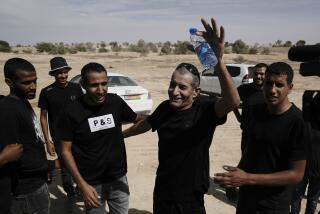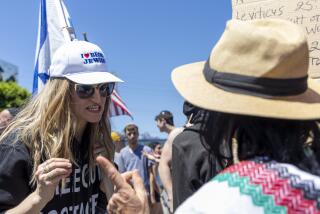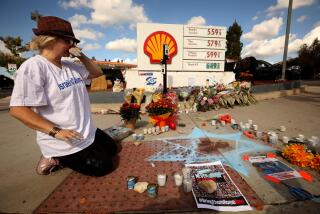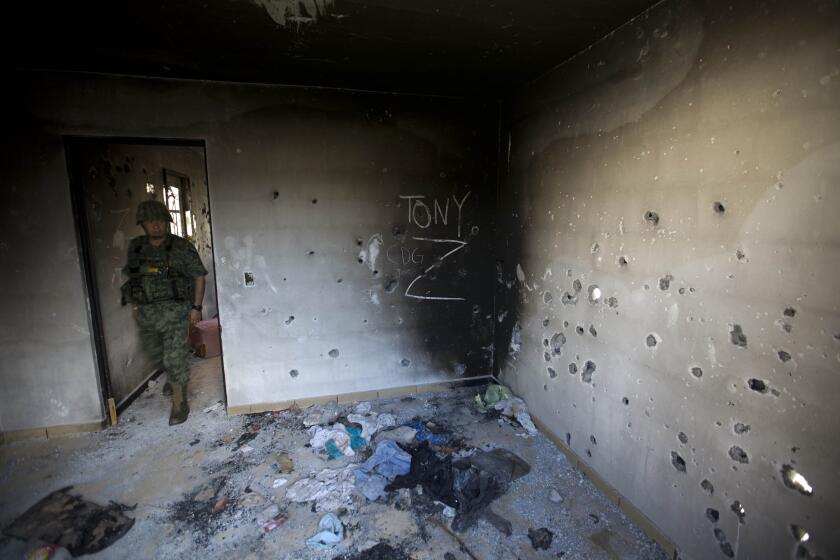Where the Search for Relics Is a Battlefield
JERUSALEM — Gideon Avni feels helpless sometimes, his work in the shadow of the great stone walls of Jerusalem’s Old City buffeted by wave after wave of angry rhetoric.
All he wants, says Avni, Israel’s chief archeologist for Jerusalem, is to uncover this city’s extraordinary history, opening up the remnants of its long and troubled past to all who wish to see them. But even dusty relics become flash points in the bitter struggle over an unhappily shared land.
“In this country, everybody is using archeology to prove something to someone,” Avni said as he lingered near a jumble of giant stone blocks just inside the Old City’s southern wall.
Behind him lay the remains of a 7th century Islamic palace; beyond that, a Herodian-era street about 2,000 years old. Across the way, the crumbling walls and pilasters of other eras--Mameluke and Byzantine, Crusader and Roman.
“Every stone we move here causes its own problems,” he said.
From Jerusalem’s Old City to the legendary fortress of Masada, archeology historically has been wielded here as a powerful weapon, used to back up or shoot down competing claims to this ancient land. But perhaps never more so than today, and nowhere as passionately as within this beloved, disputed city.
With the debate between Israelis and Palestinians over the future of Jerusalem becoming ever more explosive, arguments over its past have grown increasingly shrill.
Each side fears the other wants to ignore or eradicate its history here in order to diminish its claims to the land.
The sensitivity of the archeological debate was underscored last month with the deaths of at least 75 people in Israeli-Palestinian clashes touched off by what at first seemed almost a trivial matter: the Israeli government’s decision to open a new door to a tourist tunnel in the Old City.
The action, however, involved a section of Jerusalem that could hardly be more sensitive, containing as it does sites sacred to Muslims and Jews.
The specter of violence recently was raised again, over yet another perceived change in Jerusalem’s delicate balance. The city’s Islamic authorities announced a plan to inaugurate a new prayer area near the closely clustered holy sites, prompting warnings from Israeli security officials that the decision could spark more violence, this time by extremist Jews.
Neither Palestinian outrage over the tunnel’s new door nor predictions of Jewish anger over the new worship space should have been a surprise, experts say.
Neal Asher Silberman, a historian and author who studied archeology at Jerusalem’s Hebrew University, said rhetorical and real struggles are waged over ancient remains in political hot spots from Cyprus to South Africa.
“The past is always a metaphorical battlefield for the conflicts of the present,” said Silberman, who has written on archeology and politics, including a biography of archeologist and former Israeli Deputy Prime Minister Yigael Yadin.
For instance, sites such as Masada--the mountaintop stronghold where Jewish zealots held out against the Roman army before committing suicide in AD 73--are easily politicized, he said. For many years, he noted, Israeli army recruits were sworn in atop Masada.
The sites “become symbols that demand powerful reactions,” he said. “They’re either saluted as the dogma of the state or used as a red flag that’s waved in front of someone else. But this . . . is a misuse of what archeology can offer.”
History Ignored
In the same way, the tunnel, and comments made by Israeli leaders stressing its significance to Jewish heritage, fueled the belief of many Palestinians that evidence of all but Jewish history is often ignored, according to Silberman and others.
Since the tunnel crisis erupted, Yasser Arafat’s Palestinian Authority has tried to fight back, holding news conferences and offering lectures to accuse Israel of this tendency. In some cases, speakers have also belittled Jewish history and claimed that Palestinians are descendants of the Canaanites, whose civilization preceded that of the Israelites.
Arafat caused alarm and some outrage in Israel with a recent speech in which he briefly appeared to claim the Western Wall, Judaism’s holiest site, as a place sacred to Muslims too. The wall is considered the last vestige of Judaism’s Second Temple, destroyed nearly 2,000 years ago.
“They are trying to prove their background in the way we are accused sometimes,” said Amihai Mazar, chair of the archeology department at Hebrew University.
Earlier, one Palestinian archeologist airily discounted evidence of Jewish civilization in Jerusalem as “millimeters, not even centimeters” deep--insignificant, he argued, among the great civilizations that have ruled the Holy City.
Others, including Palestinians speaking privately, said such claims were wrong, and counterproductive in the effort to resolve political differences.
Discoveries should be viewed as expanding the history of the land for all present-day inhabitants, several academics said.
“I consider these things part of the culture of Palestine,” said Marwan abu Khalaf, director of the Palestinian-run Institute of Islamic Archeology in East Jerusalem. “They belong to everyone.”
But Palestinians spoke with one voice of what they said was a historical--some said ongoing--effort by Israel to ignore or even erase signs of Arab and Islamic history here.
They said this held true at excavations throughout the nation but was particularly egregious in Jerusalem, the focus of national and religious aspirations for both sides.
Hamdan Mohammed Taha, director of the antiquities department for the Palestinian Authority, said reports of excavations, especially those published up to the 1960s, tended to include only layers before the Islamic period, which began in AD 661.
“From the very beginning, this was more or less a fault of the archeology in Palestine,” Taha said. “Archeological research here was motivated by ideology and was linked to nationalism and Zionism.”
Several Israeli archeologists said there is evidence to support the view that many of the early digs here focused on the Jewish heritage, but they maintained that the reasons often had more to do with personal and scientific interest than with nationalist fervor. They also said such partiality has ended.
Israeli author and essayist Amos Elon has written of the enormous popularity of archeology during the period leading up to the establishment of Israel in 1948.
The “cult of archeological relics,” he wrote--the bits of ancient glass, pottery shards and lumps of marble found in parks or on rocky hillsides throughout the country--helped give an immigrant society a common culture and identity. The artifacts have provided inspiration for Israeli coins, postage stamps and even the state seal.
In those early years, though, “there was a rush to identify Jewish sites, an overemphasis on digging them up, and a tendency to expose to public view the Jewish strata of a site even where other layers may have been historically or artistically more significant or revealing,” Elon wrote in the New York Review of Books.
He largely defended the scholarship of the early archeologists, saying that while they may have been biased in their choice of study, they generally were not when it came to analyzing finds. But their discoveries were used and manipulated by others, including Bible teachers, nationalist historians and politicians, he wrote.
These days, however, the tendency to focus on Jewish remains has been reversed among Israeli archeologists, according to Avni and others. Several of their Palestinian counterparts, including Taha, generally agreed, saying younger Israeli archeologists tend to have broader scientific interest.
Avni pointed to the ongoing reconstruction of a palace from the early Islamic, or Umayyad, period near the Old City’s southern wall as proof that Israel preserves some Islamic and Arab remains.
The reconstruction is expected to cost about $3 million, including $2 million from the Israeli government and $1 million from a Jewish American donor.
“Only a crazy state like Israel would invest $2 million to rebuild an Umayyad palace,” joked Amir Drori, who heads the Israel Antiquities Authority, for which Avni works.
Angering Both Sides
But when the rebuilding was announced as part of a government plans for an archeological park--one of the most ambitious digs Israel has undertaken--it raised a furor among Muslim and Jewish religious officials.
Muslim leaders were angry because remains of a second Islamic palace would be dismantled to expose a section of the Herodian street beneath it. Regaining one structure would not make up for losing another, they said.
Jewish religious authorities objected to the archeologists’ plan to reuse ancient stone blocks, some up to 7 feet long, that are believed to have been dislodged from the Western Wall by the Romans when they destroyed the Second Temple and Jerusalem.
The rabbis argued that Jewish law forbids the use of stones that may have been used in the temple to build an Islamic structure.
Jewish nationalist groups also fought the project and filed an unsuccessful legal action, Avni said.
“They were really angry,” he said. “They said, ‘How dare you reconstruct an Islamic palace in this country, especially in Jerusalem?’ They wanted us to tear it down.”
Of the tunnel, antiquities authority officials said they long ago recommended that a new door be created but that they were not notified before it was done.
Previous Israeli governments had rejected the idea of completing the passage, which has been open to visitors since 1991. But its proximity to the vast, raised plaza known to Jews as the Temple Mount and to Arabs as Haram al Sharif, the Noble Sanctuary, made it too sensitive politically.
Two mosques, the gold-crowned Dome of the Rock and Al Aqsa, one of the holiest sites in Islam, rise above the mount, built over what is believed to have been the site of the lost Jewish temple.
Israeli officials said the new exit was created primarily to allow more tourists to see the relics the tunnel contains from many eras.
Palestinians reacted with outrage. The new door represented a change in Jerusalem’s status quo and an attempt by Israel to assert its sovereignty over the holy places, they said.
Fear of Explosives
Jerusalem’s Islamic Trust, known as the Waqf, also reiterated concerns--dismissed by Israeli officials--that the passage could undermine the footings of the mosques above the mount. And many Palestinians, mistakenly believing that the tunnel ran directly under the mosques, voiced fears that extremist Jews could plant explosives there to clear the site for the temple’s rebuilding.
As violence erupted in the West Bank and Gaza Strip, Israeli officials said the Waqf, in a secret deal late last year, had agreed to the new exit in exchange for Israel’s compliance with its plan to expand Al Aqsa’s capacity by opening several chambers beneath it.
Islamic authorities denied that there was ever such an agreement.
Nonetheless, two weeks after the tunnel’s new door swung open, the Waqf announced that the huge space under the mosque was under renovation and would soon be inaugurated. The Israeli government reacted relatively mildly, but right-wing religious groups seized upon the announcement. It was evidence, they claimed, that Muslims planned to erase all traces of Jewish heritage from the Temple Mount.
According to Silberman, such tensions are almost inevitable when archeology is undertaken in a charged political atmosphere. He criticized Prime Minister Benjamin Netanyahu and other Israeli leaders for using the tunnel to emphasize Israel’s sovereignty.
Some Israeli archeologists, too, have criticized the government’s decisions on the tunnel. Shortly after the crisis erupted, Mazar signed a statement placed on the Internet by a group of French archeologists condemning the political use of their discipline.
In the wake of the uproar, many of those interviewed said they worried whether Israelis and Palestinians can resolve the question of sovereignty over the riches buried in the land they share.
“What happens when you have a continuous site that has everything from biblical to Islamic remains and beyond?” Silberman asked. “Does one side get the first 20 feet of the dig and the other get the next? Maybe they’ll figure out how to work together.”
*
Batsheva Sobelman of The Times’ Jerusalem Bureau contributed to this report.
More to Read
Sign up for Essential California
The most important California stories and recommendations in your inbox every morning.
You may occasionally receive promotional content from the Los Angeles Times.










